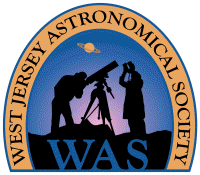| Weather Links |
Mercury 2022 last
sighting February 6 |
Lunar X |
Venus after Sunset at East Point
December 26, 2021
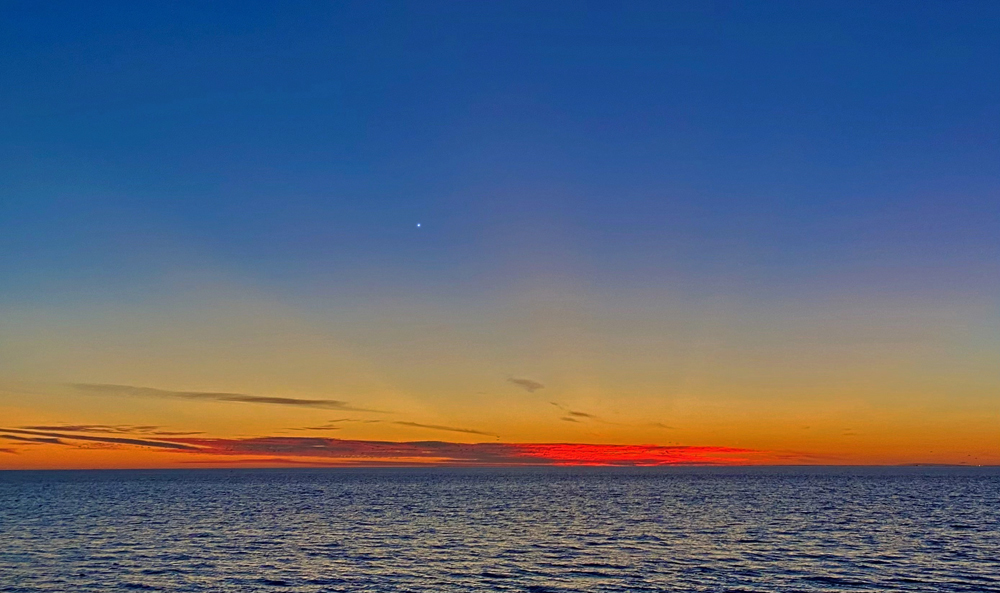
|
Looking over the Delaware Bay from East Point, NJ,
Venus appears in
bright twilight on
December 26, 2021, at 5:07 pm EST, 23 minutes
after sunset at 4:44 pm. Crepuscular rays are also visible
radiating from the solar point below the horizon and fiery
orange clouds along it. Taken with a handheld iPhone 11, it was
exposed 1/82 second at f/1.8, ISO 125. It was cropped to 69% of the original width and 54% of the
height
and mildly adjusted with Adobe Photoshop Elements. Mouseover for a label.
At the time, Venus was about 11.9°
altitude in eastern
Sagittarius. At magnitude -4.4, it was spotted with unaided
eyes at 4:30 pm, and being 58″
diameter and 5.8% illuminated,
it displayed a bright thin crescent
in 15x56 binoculars. Venus will be at inferior
conjunction on January 8, 2022. Mercury was
6° below Venus, but it could not be found in this image. It was
seen with with the 15x56s at 5:00
pm when it was at 7.0° altitude and then glimpsed with unaided
eyes at 5:24 pm, 3.4° altitude. The ultimate target of the trip,
comet C/2021 A1 (Leonard),
was spotted with an 88 mm apo spotting scope at 5:45 pm, and
shortly after 6 pm, comet 19P/Borrelly
was spotted with the same scope.
Uranus and
Neptune were
seen with the 15x56s. |
Comet C/2021 A1 (Leonard)
December 23, 2021
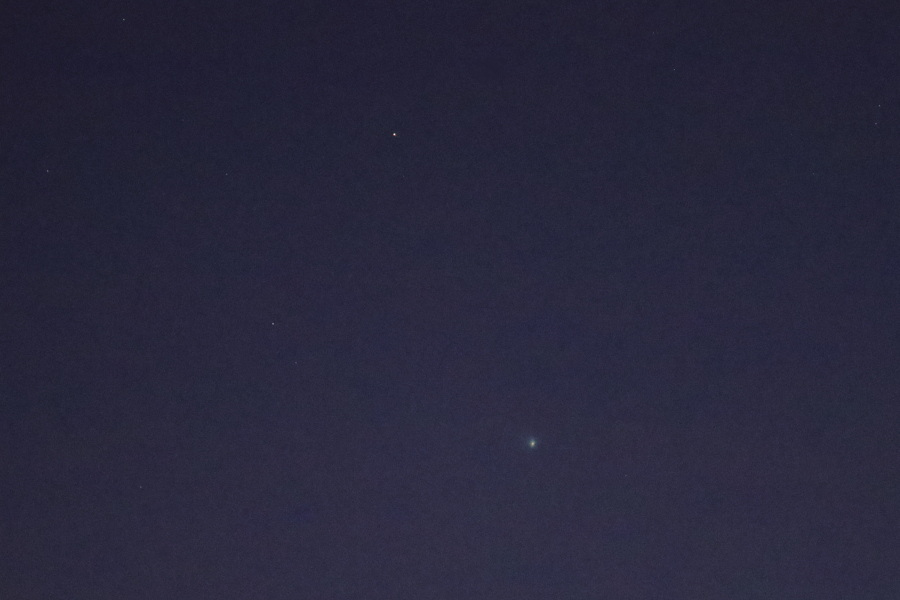
|
This snapshot showing Comet C/2021
A1 (Leonard) through thin clouds in the evening sky was taken on
December 23, 2021, at 5:43 pm EST from the
baseball field complex in Maple
Shade, NJ, with a Canon EOS RP mirrorless
digital camera and a Canon 400 mm f/5.6L lens (on a fixed
tripod). It's a single raw frame manually exposed 0.3 second at
f/5.6, ISO 6400.
It was mildly adjusted and set to
4000 K white balance, then cropped to 48% of the original linear
dimensions with Canon's Digital Photo Professional
4.
The resultant field is 2.5° wide x 1.7° high.
Comet Leonard
was initially spotted at 5:33 pm EST, about 8.1°
altitude in
Microscopium, about a degree southwest of Gamma Mic, with
15x56 binoculars and followed to about
5:50 pm, all the while, thin clouds partially obscured the view. While at the
baseball field, Mercury was spotted with the 15x56s at 5:08
pm when it was at 3.7° altitude. The thin
crescent of Venus
could also be seen in the 15x56s, aided by the thin clouds
tempering the brilliance. Venus is 16 days from inferior conjunction on January 8, 2022,
and is now 55.8″ diameter and 8.2% illuminated.
The image below is a further crop,
14% of the same
original raw frame, to better show the coma; the field is 0.75° wide x
0.50° high. |
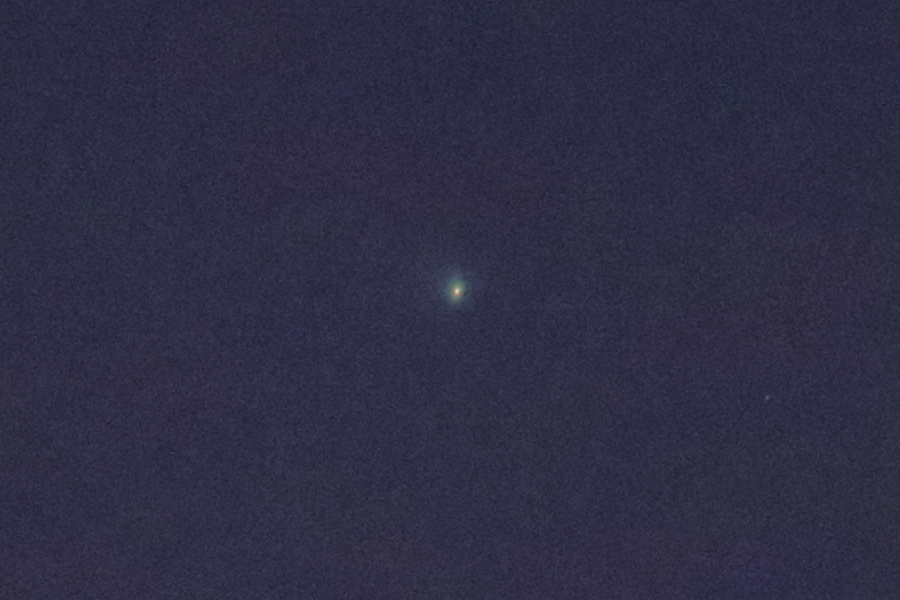
Comet C/2021 A1 (Leonard)
December 20, 2021
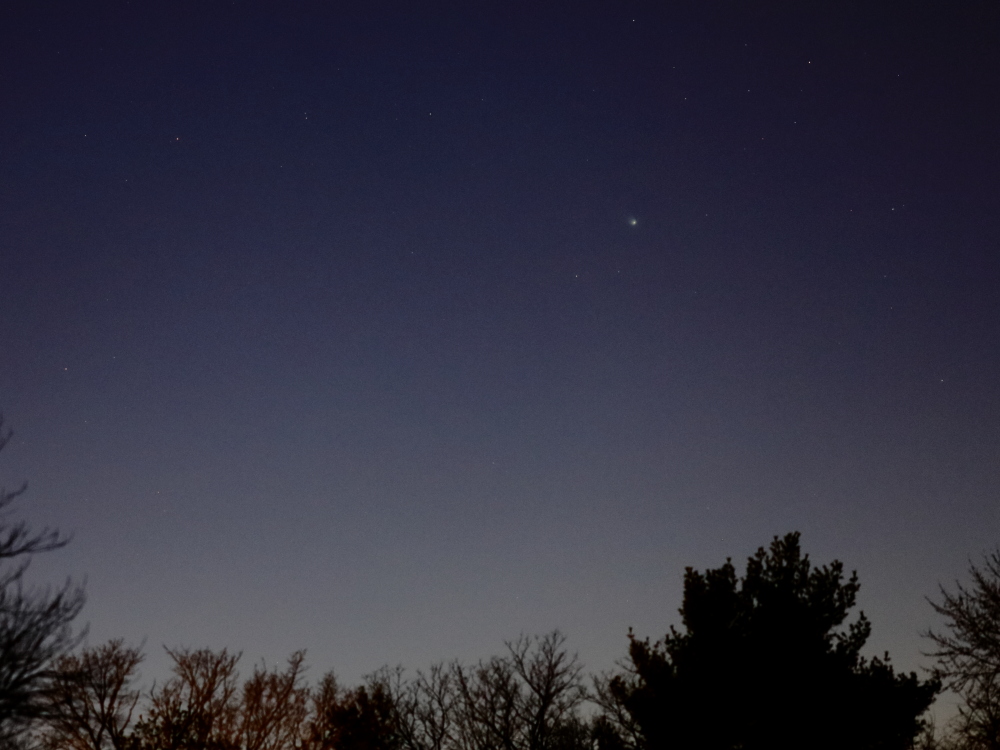
|
This snapshot showing Comet C/2021
A1 (Leonard) in the evening sky was taken on
December 20, 2021, at 5:45 pm EST from the
baseball field complex in Maple
Shade, NJ, with a Canon EOS RP mirrorless
digital camera and a Canon 200 mm f/2.8L lens (on a fixed
tripod). It's a single raw frame manually exposed 1/2 second at
f/2.8, ISO 1600.
The brightness and contrast were mildly adjusted, it was set to
5000 K white balance and cropped to about 72% of the original linear
dimensions with Canon's Digital Photo Professional
4.
The resultant field is 6.9° wide x 5.2° high.
Comet Leonard was initially spotted at 5:29 pm EST, about 8.5°
altitude in
Sagittarius (close to the
Microscopium border), with an 88 mm spotting scope at 25x; it was subsequently
seen with 15x56 binoculars. The comet was lost behind tree
branches at about 4° altitude around 6:05 pm. While at the
baseball field, Mercury
was spotted with the 15x56s at 5:01 pm when it was around 3°
altitude (in a "notch" of the tree line). The thin crescent of
Venus was
also observed in the spotting scope, at 60x. It's 19 days from
inferior conjunction on January 8, 2022, and is now 53.5″
diameter and 11% illuminated.
The image below is a further crop, nominally 20% of the same
original raw frame, to better show the coma and a faint
wash of the tail; the field is 2.0° wide x 1.5° high. |
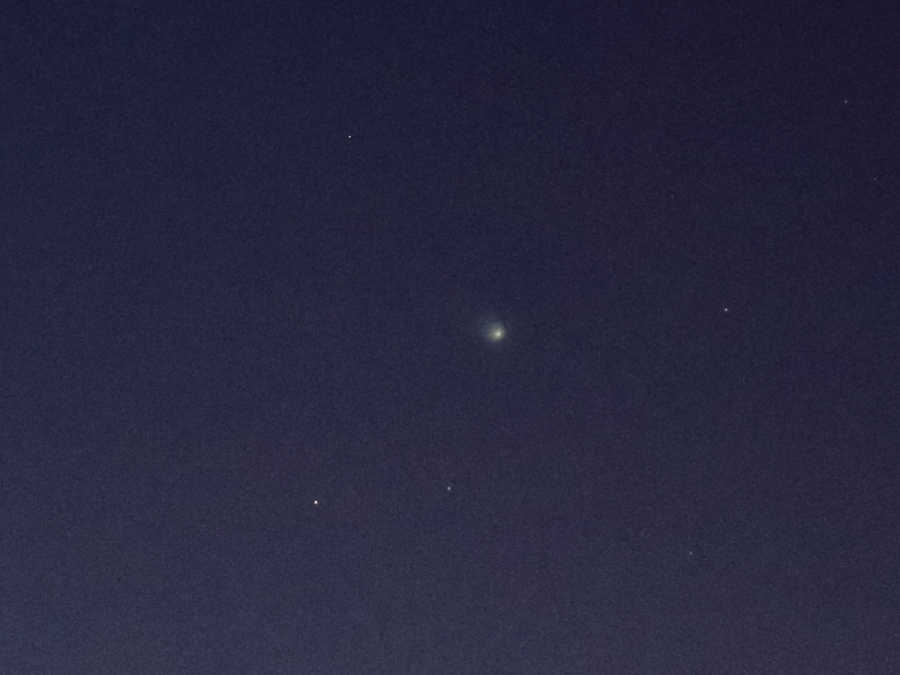
Comet C/2021 A1 (Leonard)
December 7, 2021
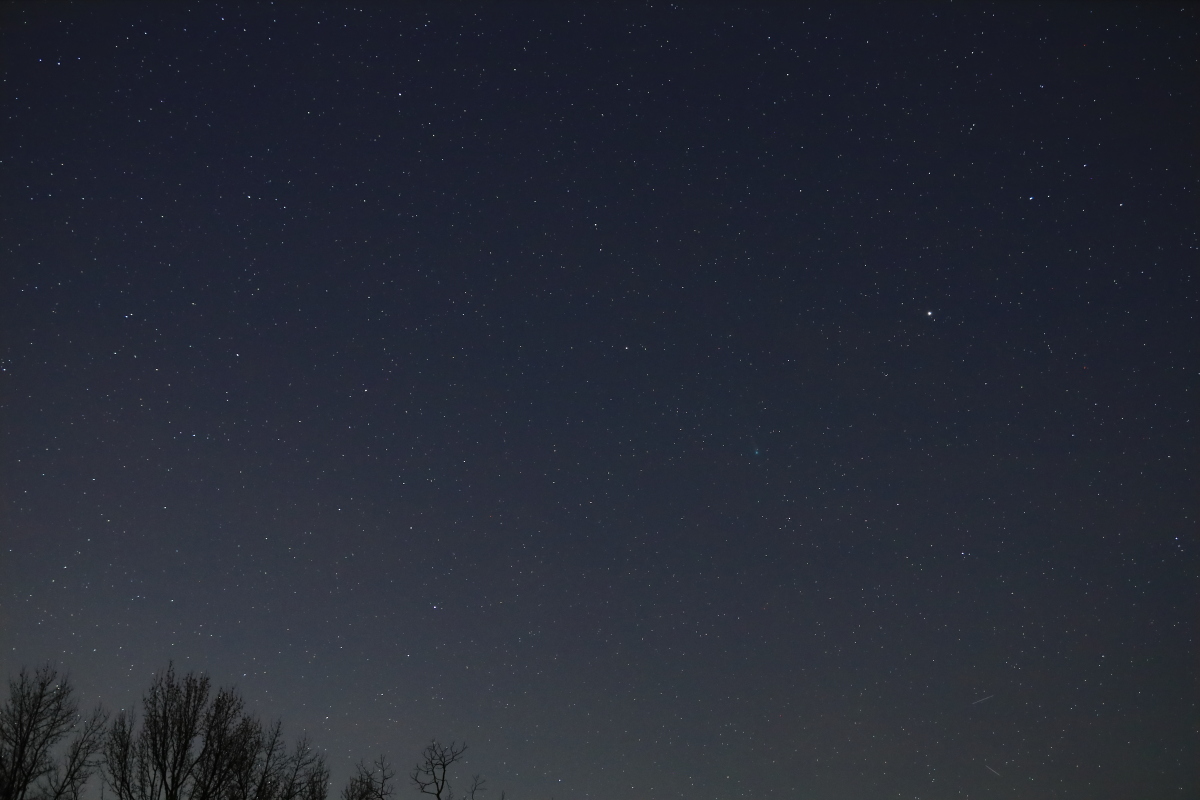
|
This snapshot showing Comet C/2021
A1 (Leonard) was taken on
December 7, 2021, at 4:39 am EST from Atsion
Field in Wharton State Forest, NJ, with a Canon EOS RP mirrorless
digital camera on a fixed tripod and a Sigma 50 mm f/1.4 Art lens. It's a single raw frame manually exposed
3.2 seconds at
f/2.0, ISO 3200.
It was mildly adjusted and set to
3800K white balance with Canon's Digital Photo Professional
4.
This uncropped field is 39.5° wide x 27.0° high. Mouseover
for labels.
The image below is the same raw frame with the same adjustments,
but cropped to 19% of the original linear dimensions (to better
show the comet) for a field 7.9° wide x 5.3° wide. Mouseover
for labels. Comet Leonard
is sinking quickly in the morning before sunrise above the
eastern horizon. Here's a
table of altitudes for the mornings of December 7 through
11, 2021. Here's an
MPC ephemeris for Dec 12 (perigee) through Jan 5 (perihelion
Jan 3, 2022). At the time of this image, 4:39 am, Leonard was at
24.5° altitude. It was not visible with unaided eyes, but it was
an easy object in 8x42 binoculars, showing a pale greenish coma
and a diaphanous, colorless extending a degree or so vertically.
It was seen again during the pre-dawn hours of December 9. In my
115 mm (and even the 8x42s), its 19 arc sec/minute movement was
quickly apparent. |
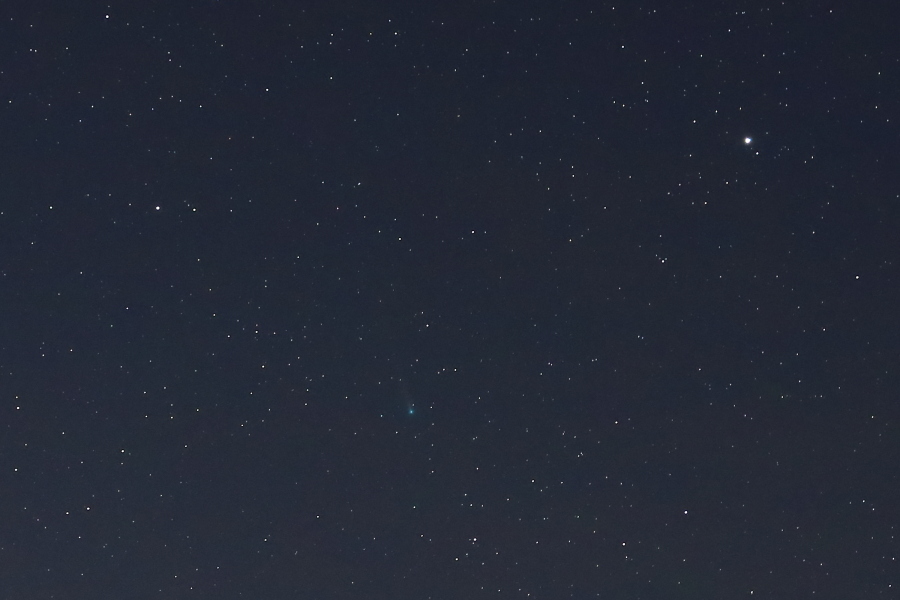
Comet C/2021 A1 (Leonard) near Messier 3
December 3, 2021
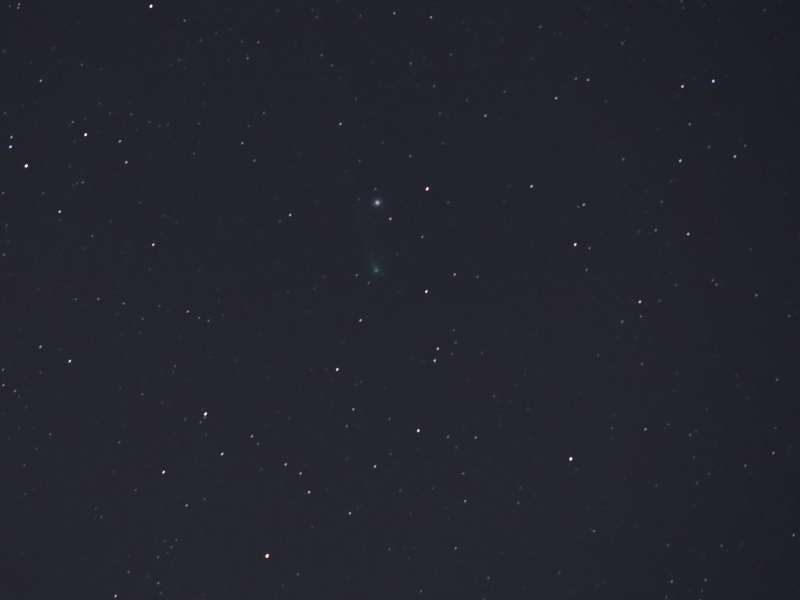
|
This snapshot shows
Comet C/2021
A1 (Leonard) near the globular cluster
Messier 3. It was taken
at 4:13 am EDT on
December 3, 2021, from Wharton State Forest, NJ, with a Canon EOS RP mirrorless
digital camera and a Canon 200 mm f/2.8L lens (on a fixed
tripod). It's a single raw frame manually exposed 4 seconds at
f/3.2, ISO 6400,
3800K white balance. It was not processed, except for cropping to 67% of the original linear
width and 76% of the height, yielding a 4:3 ratio
and a field 6.9° wide x 5.2° high. This is a correct view, the
width of the image is parallel to the horizon and the zenith is
up. Mouseover for labels.
Comet Leonard
and M3 were visually observed with 15x56 binoculars, after the
sky cleared around 3:30 am; the
field of view was roughly comparable to the picture above. They were
also observed with a 115 mm apo spotting scope at 30x, which
provided a 2° true field of view, as shown in this
second labeled version of the same image. I watched the
comet with the scope until about 5:45 (about 18 minutes after
the start of astronomical twilight) am (except for 20 minutes
around 4 am when I was taking pictures). During those two hours,
motion of the comet was clearly detected as shown on the
mouseover of the image above. The
MPC Ephemeris indicated the comet moving at a rate of
6.8"/minute at the time, which would produce about a quarter of
a degree movement during the two hours of observation. This rate
of movement was confirmed with SkyTools, by measuring the
observed positions of the coma against the background star
field, in particular, the two stars just left of the coma in the
picture; their proximity produced a large swing in the relative
position angle.
Besides the coma, which visually had a pale greenish color in
the scope view that was in distinct contrast to the white color
of M3, there was a colorless, gossamer tail visible in the
binoculars, but especially in the spotting scope. It extended
faintly to just left of M3. The span between the coma and M3 was
about half a degree at 3:30 am, increasing to about
three-quarters of a degree at 5:45 am. During that time, the
comet's altitude increased from 24° to 49.5°.
Finally, just before the start of astronomical twilight, we
noticed some vague zodiacal light extending up through Virgo.
We remained on the field until 7 am hoping to spot the sublimely
thin crescent of a nominal 20-hours-before-new moon. Sunrise was
at 7:05 am, but variegated clouds along the horizon in the
direction of the rising moon and sun precluded a reasonable
chance for a sighting, but they did exhibit a beautiful deep
orange color on their undersides, almost as if the distant
forest was on fire. |
Comet C/2021 A1 (Leonard)
November 30, 2021
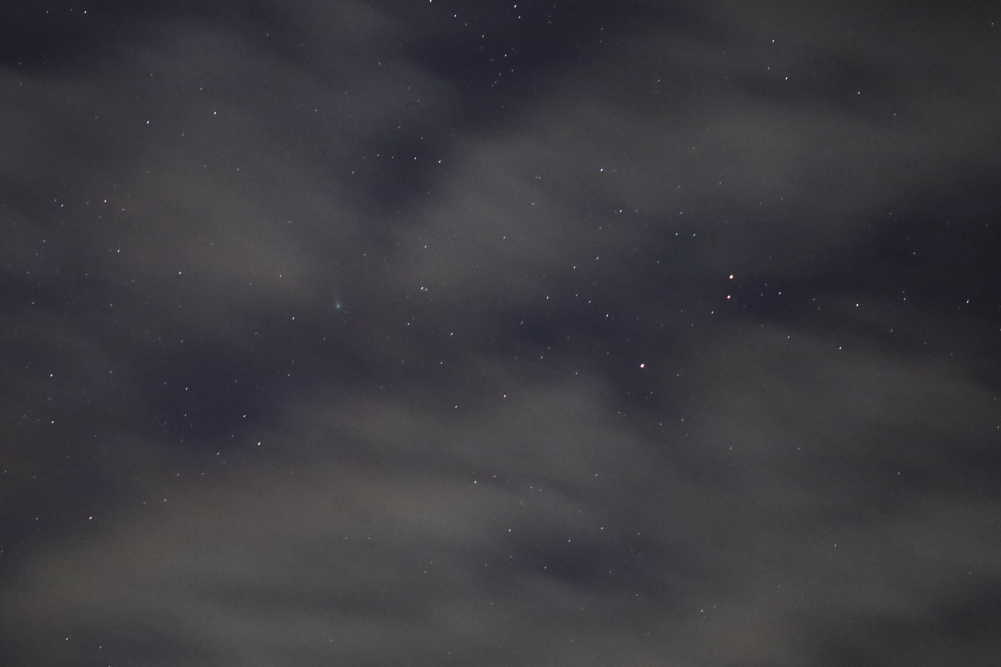
|
This snapshot showing Comet C/2021
A1 (Leonard) was taken on
November 30, 2021, at 3:24 am EST from Wharton State Forest, NJ, with a Canon EOS RP mirrorless
digital camera and a Canon 200 mm f/2.8L lens (on a fixed
tripod). It's a single raw frame manually exposed 4 seconds at
f/2.8, ISO 6400.
The brightness and contrast were mildly adjusted, it was set to
3800K white balance and cropped to 80% of the original linear
dimensions with Canon's Digital Photo Professional
4.
The resultant field is 8.2° wide x 5.5° high. The 21%
illuminated crescent moon was about 33° south of the comet.
As soon as I arrived at 3:05 am, before the clouds had started
to cover the comet, I grabbed my 15x56 binoculars and was able
to spot
Comet Leonard about 3° to the left of Beta and 41 Comae
Berenices. It was not difficult to see the fuzzy comet, unlike
previous attempts on Nov 19 and 23 when it was barely visible in
the binoculars. I then looked with my 115 mm apo spotting scope
and the coma was obvious, with a fainter extension upwards (the
tail). |
The Partially Eclipsed Moon
November 19, 2021
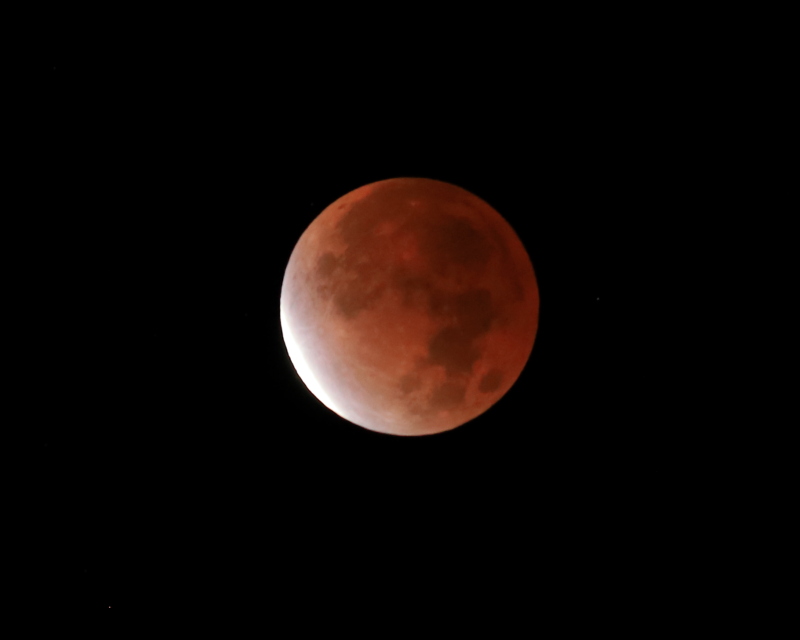
|
There was a
near-total partial lunar eclipse on the morning of
November 19, 2021. At its
4:03 am EST peak, the
earth's shadow covered more than 97% of the apparent face of the
moon. This snapshot of the eclipsed moon was taken at 3:54 am
from Wharton State Forest, NJ, with a Canon EOS RP mirrorless
digital camera and a Canon 400 mm f/5.6L lens (on a fixed
tripod). It's a single raw frame manually exposed 1/8 second at
f/5.6, ISO 2500 with daylight white balance.
The brightness was lightly adjusted, it was cropped to a 5:4
ratio (29% x 35% of the original linear dimensions) then
converted to this JPEG with Canon's Digital Photo Professional
4.
The field is 1.5° wide x 1.2° high, the moon is 29.7 arc minutes
diameter.
While a dark sky isn't necessary to see such a lunar
eclipse, viewing from a dark site is a wonderful experience
because the starry sky, washed out by the bright, non-eclipsed
full moon, becomes star studded as the eclipse deepens. In this
case, a cold front passed through overnight. Temperatures
dropped from the low 70°F range at home in the suburbs on the
afternoon of Nov 18 to the upper 30°F range while viewing the
eclipse in the Pines. Despite some rain overnight, after the
clouds fully cleared around 3 am, it was bone dry with
absolutely no dew and the transparency was about as good as it
gets in New Jersey. Alas, the seeing wasn't that good. In my 88
mm apo spotting scope at 25 to 60x, the limb of the eclipsed
moon wiggled conspicuously.
In any case, at 2:50
am, more then an hour before maximum eclipse, I was able to spot comet
C/2021 A1 (Leonard) in the constellation Coma Berenices
with relative ease using 15x56 binoculars, then confirmed it the
88 mm scope. The latter showed a hint of a
tail extending vertically. Comet Leonard was the subject of the
APOD (Astronomy Picture of the Day) for
November 21, 2021, although the image was captured November
13, about 4 am PST (12 UT) based on comparison to a SkyTools
chart. |
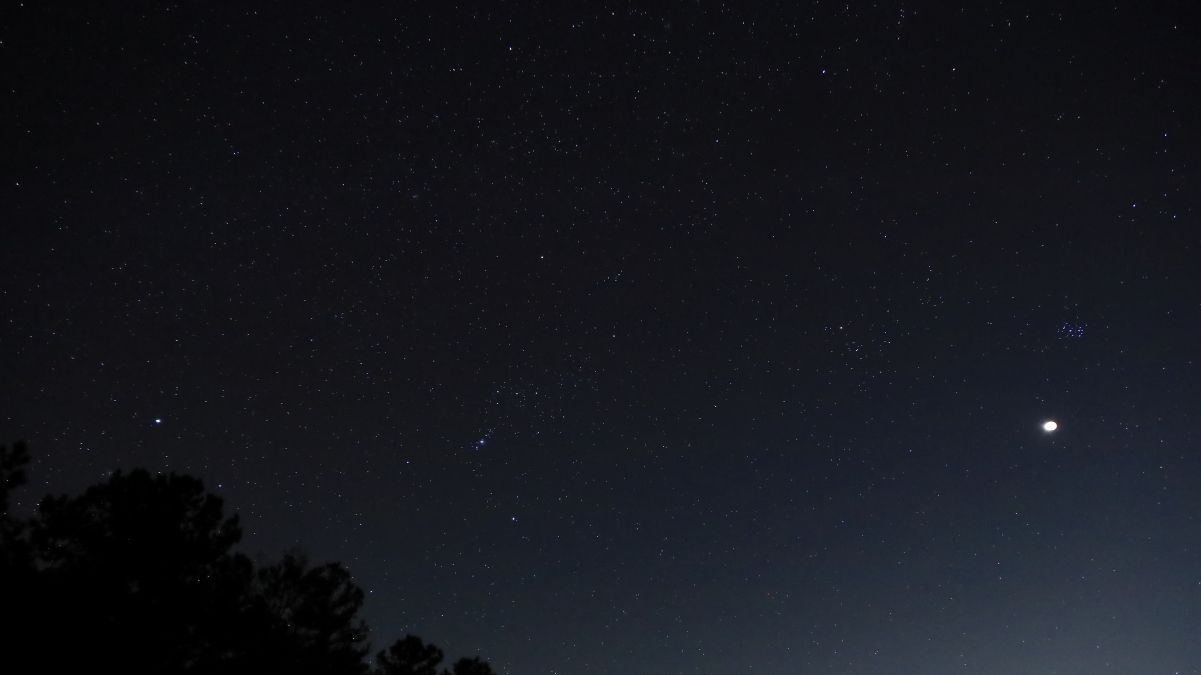
|
This is a wide-field view taken at 4:18 am EST
on
November 19, 2021. The eclipsed moon is on the
right, but it's greatly overexposed, +6.7 stops or 100x as much
light compared to the above moon-only shot (mouseover for labels).
Taken with the Canon EOS RP on a fixed tripod using a Canon
24-105 mm f/4L zoom lens set to 24 mm focal length. It
was exposed 5 seconds at f/4, ISO 3200 and 3800K white balance.
Cropped vertically to a 16:9 ratio for a field 75° wide
by 47° high. |
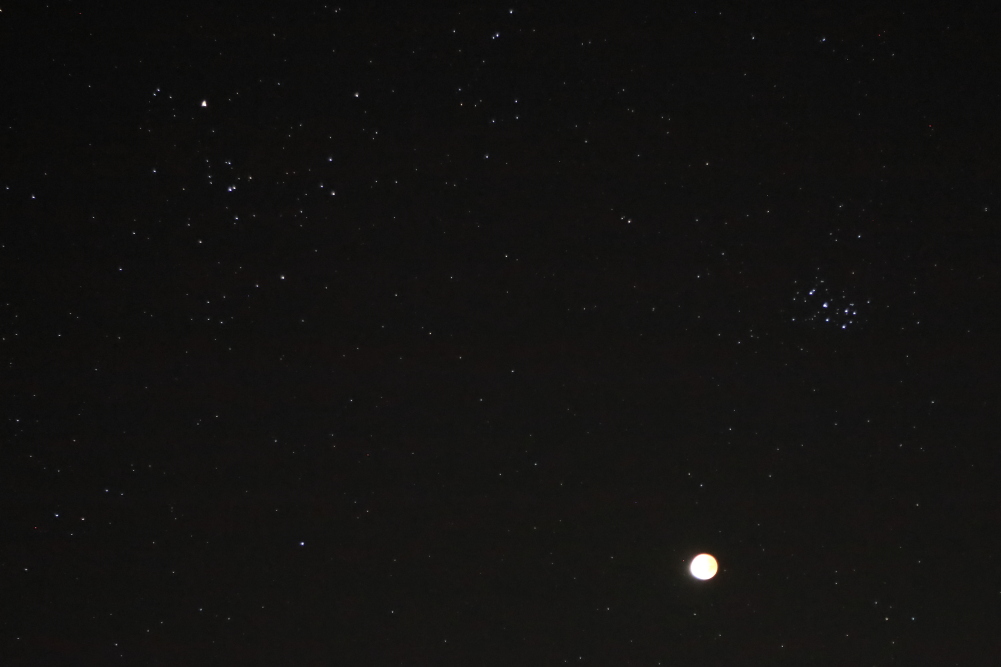
|
Finally, I wasn't going to use this picture from
November 19, 2021. It shows a tighter view of
the eclipsed moon along with the Pleiades and the Hyades star
clusters at 4:10 am EST. However, the moon was overexposed to begin with,
washing out most of the orange umbra, then made worse because I had to
increase brightness by 1.5 stops in Canon's Digital Photo
Professional for the stars to show decently. The only
redeeming value of the picture is that the asteroid (1) Ceres is
visible in the Hyades (mouseover for labels).
Compare
the position of Ceres here to the picture below from November
10. Ceres has moved almost 2° since then and over 3° since
November 3 when I saw it just 7 arc minutes from Aldebaran.
Ceres will be at opposition on November 26, outside of the
Hyades. Taken with a Canon
EOS RP on a fixed tripod using a Canon 24-105 mm f/4L zoom lens
set to 70 mm focal length. It
was exposed 2 seconds at f/4, ISO 3200 and daylight white balance.
Cropped to about 72% of the original linear dimensions yielding a field
21° wide
by 14° high. |
(1) Ceres in the Hyades
November 10, 2021
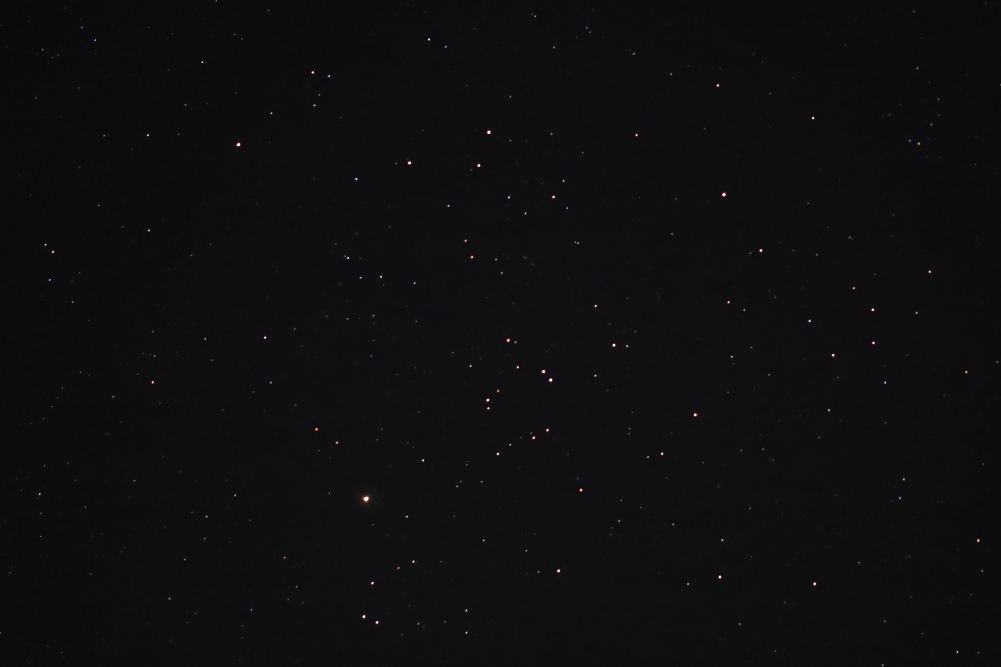
|
This image with the asteroid (1) Ceres
was captured on
November 10, 2021, as it mingled with the
Hyades star cluster, which marks the face of
Taurus the Bull.
Ceres is the largest asteroid (or minor planet) and is also
categorized as a dwarf planet. It shines here at magnitude 7.6,
so it wasn't a difficult binocular object. Ceres will reach
opposition on November 26, magnitude 7.2. Taken at 9:35 pm EST
with a Canon EOS RP mirrorless digital camera and a Canon 200 mm
f/2.8L lens (on a fixed tripod). It's a single raw frame
manually exposed 2 seconds at f/2.8, ISO 3200. It was cropped
(to 80% of the original dimensions) and mildly adjusted, then
converted to this JPEG, with Canon's Digital Photo Professional
4.
The field is 8.2° wide x 5.5° high. Mouseover for labels.
Besides my general interest in spotting asteroids, especially
those with single-digit numbers, I wanted to unambiguously check
the position of (1) Ceres. Earlier in the week, while at a
friend's home observing from his backyard, I tried to spot
Ceres with binoculars; however, I mistakenly left my smartphone
at home, so I didn't have access to SkySafari to establish the
position. My friend was using his Win 10 laptop to operate his
astro-camera and he had Stellarium on it (version unknown). We
looked up Ceres, but alas, I couldn't find an object at the
indicated position with my 8x42s. Was there too much light
pollution in the suburban backyard to see it with them?
When I returned home, I double-checked Ceres' position with
Stellarium 0.19.0 and SkyTools 3 & 4 on my Win 10 laptop. as
well as SkySafari 6 and Stellarium Mobile Plus v1.7.6 on my
iPad. SkyTools, SkySafari and Stellarium Mobile all had Ceres in
the same spot, Stellarium 0.19.0 was alone with Ceres in a
different, and apparently wrong spot. I needed a field check. On
November 10, my visual observation with 15x56 binoculars and my
88 mm apo spotting scope at 25 to 60x, as well as this photo,
showed that the SkyTools
et al.
position is correct and Stellarium
0.19.0 is not. I suspect that it has outdated orbital elements. I don't
use Stellarium that often, so I don't know what provision there
is for updating elements, and it's not a high priority for me to
find out. Perhaps I should just download the latest version,
Stellarium
0.21.2. |
The Old Crescent Moon and Mercury
November 3, 2021
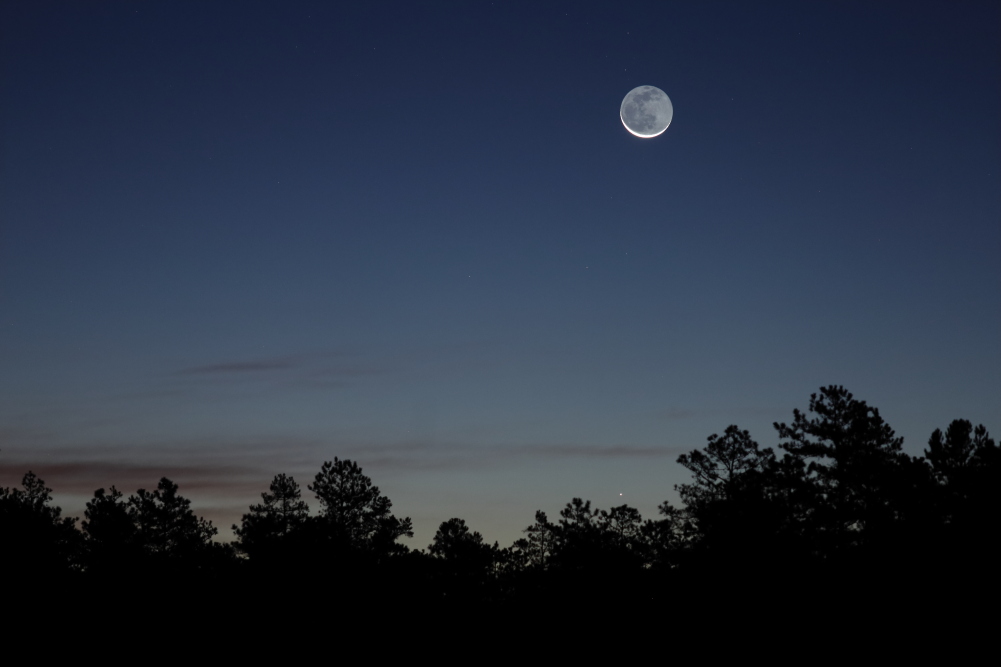
|
At 6:31 am EDT on the morning of
November 3, 2021, the 28.0-day-old
Crescent Moon
joined the planet Mercury
above the treetops before sunrise in Wharton State Forest,
NJ. At the time, about an hour before sunrise at 7:30 am, the
Moon was at 7.5° altitude, 2.8% illuminated (but
filled with earthshine)
and 34.7 hours before new. Magnitude -0.9 Mercury was at 3.5°
altitude and 15.3° from the sun. It will reach superior
conjunction on November 28, 2021.
Taken with a Canon EOS
RP mirrorless digital camera and a Canon 200 mm f/2.8L lens (on a fixed tripod). It's a single
raw frame manually exposed 1/2 second at f/2.8, ISO 1600
and 3600K white balance.
It was not cropped or adjusted, just
converted to this JPEG with Canon's Digital Photo Professional
4.
The field is 10.3° wide x 6.9° high. Mouseover for labels. |
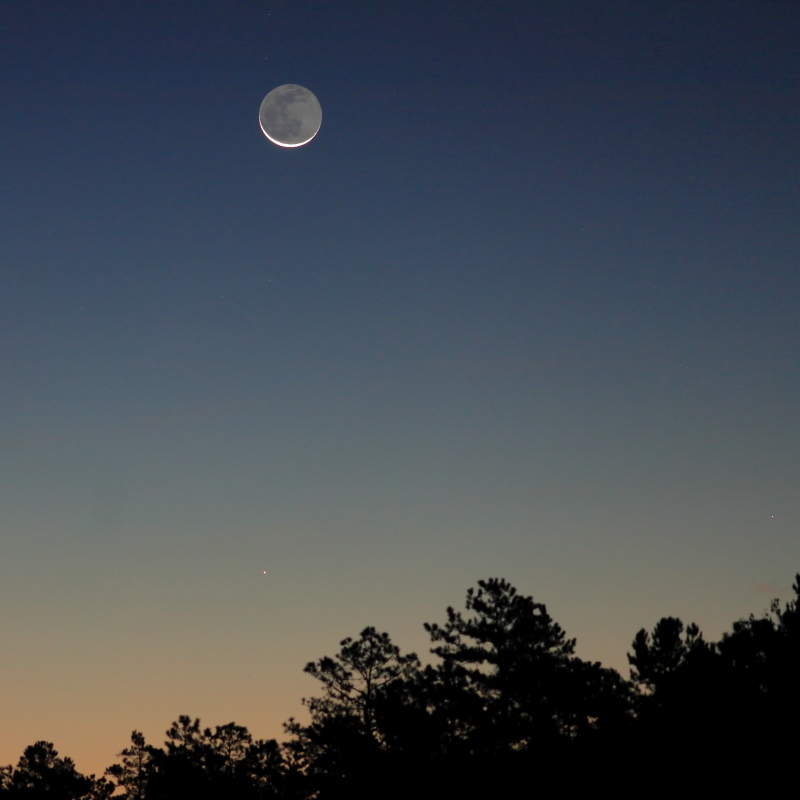
|
Here's another image, taken at 6:40 am EDT on
November 3, 2021. In addition to the
Crescent Moon
and Mercury, the first-magnitude star Spica
(Alpha Virginis) can be seen
above the treetops at the right edge of the frame. I was lucky
to catch it because I wasn't paying much attention to the field
stars at the time. By then, the Moon reached 9.0° altitude,
Mercury 5.1° and Spica 5.5° altitude.
Taken with a Canon EOS
RP mirrorless digital camera and a Canon 200 mm f/2.8L lens (on a fixed tripod). It's a single
raw frame manually exposed 1/4 second at f/2.8, ISO 400
and 3600K white balance.
It was cropped to two-thirds of the width and almost all of the
height for a field 6.8° square. Brightness and contrast were
lightly adjusted, color balance was set to 4800K, then it was converted to this JPEG,
all with Canon's Digital Photo Professional
4.
Mouseover for labels. |
Zodiacal Light
November 3, 2021
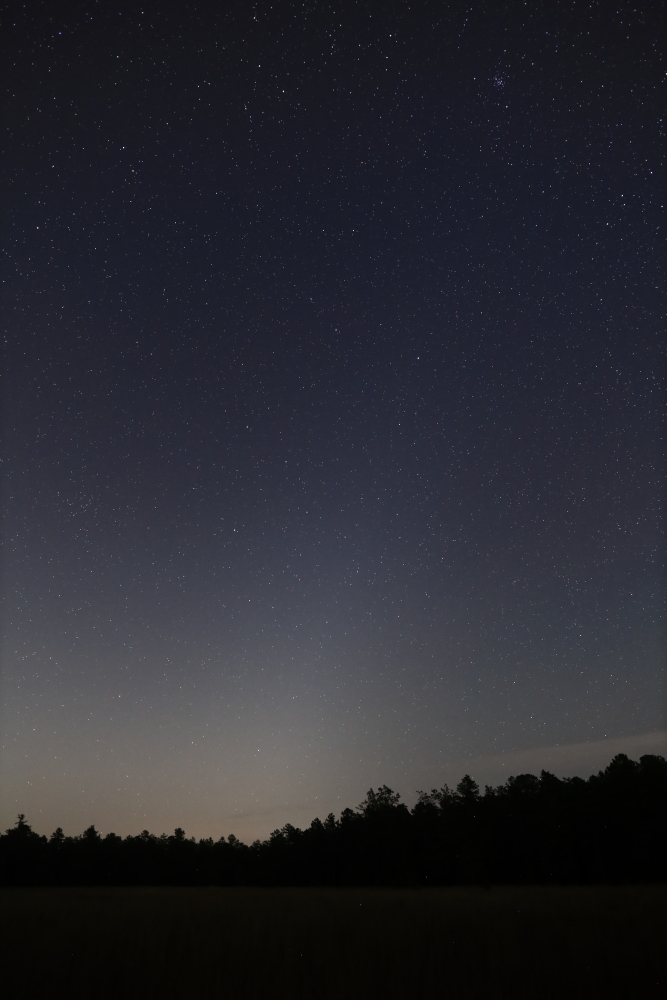
|
On the morning of November 3, 2021,
the Zodiacal Light
rose up from the eastern horizon (where the constellation Virgo
was rising) and then extended up under the belly of Leo towards
Regulus. The
Zodiacal Light is a faint glow from sunlight reflected off
interplanetary "dust" in the solar system. It shows best on fall
mornings (or spring evenings) when the ecliptic is at a
relatively steep angle to the horizon for those of us at 40°N
latitude. Unfortunately, this morning didn't have great
transparency, there was a lot of moisture remaining from the
previous day's rain and I went through many patches of fog as I
drove there and back. It was also chilly, just 32°F when I left
the field at 6:45 am EDT. As a result, the direct visual
appearance was weak and the photo not much better. Bob King has
a nice image of the ZL at the end of this
online Sky & Telescope article.
Mouseover for labels.
Taken at 5:49 am EDT, 9 minutes before the start of astronomical
twilight, with a Canon EOS
RP mirrorless digital camera (on a fixed tripod) and a Sigma 20
mm f/1.4 Art lens. It's a single
raw frame manually exposed 8 seconds at f/2.0, ISO 3200
and 3800 K white balance.
It's uncropped for a field 62° wide x 84° high.
Contrast was increased with Canon's Digital Photo Professional 4,
then it was converted to this JPEG, but no other adjustments were made. |
Click here
for the previous page.
Click here
for an index to all previous SJAstro pages.
















